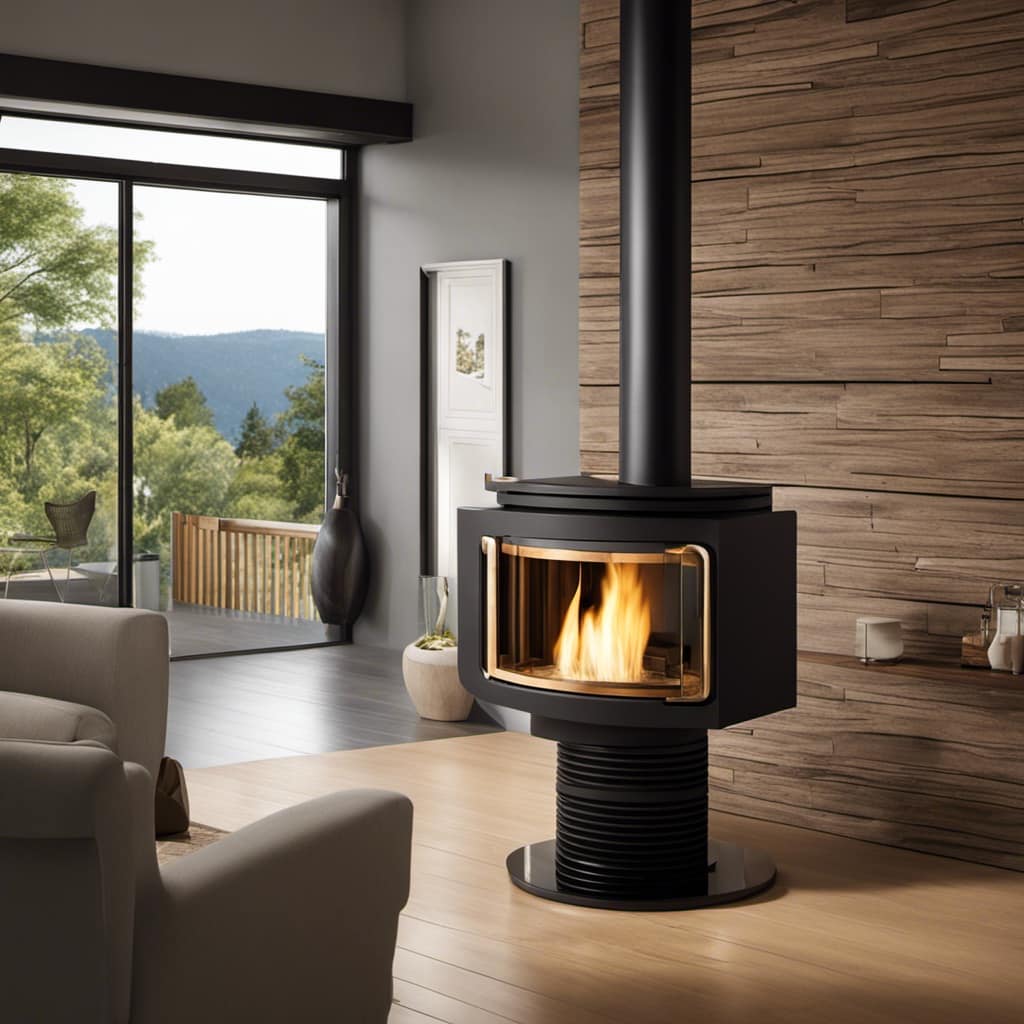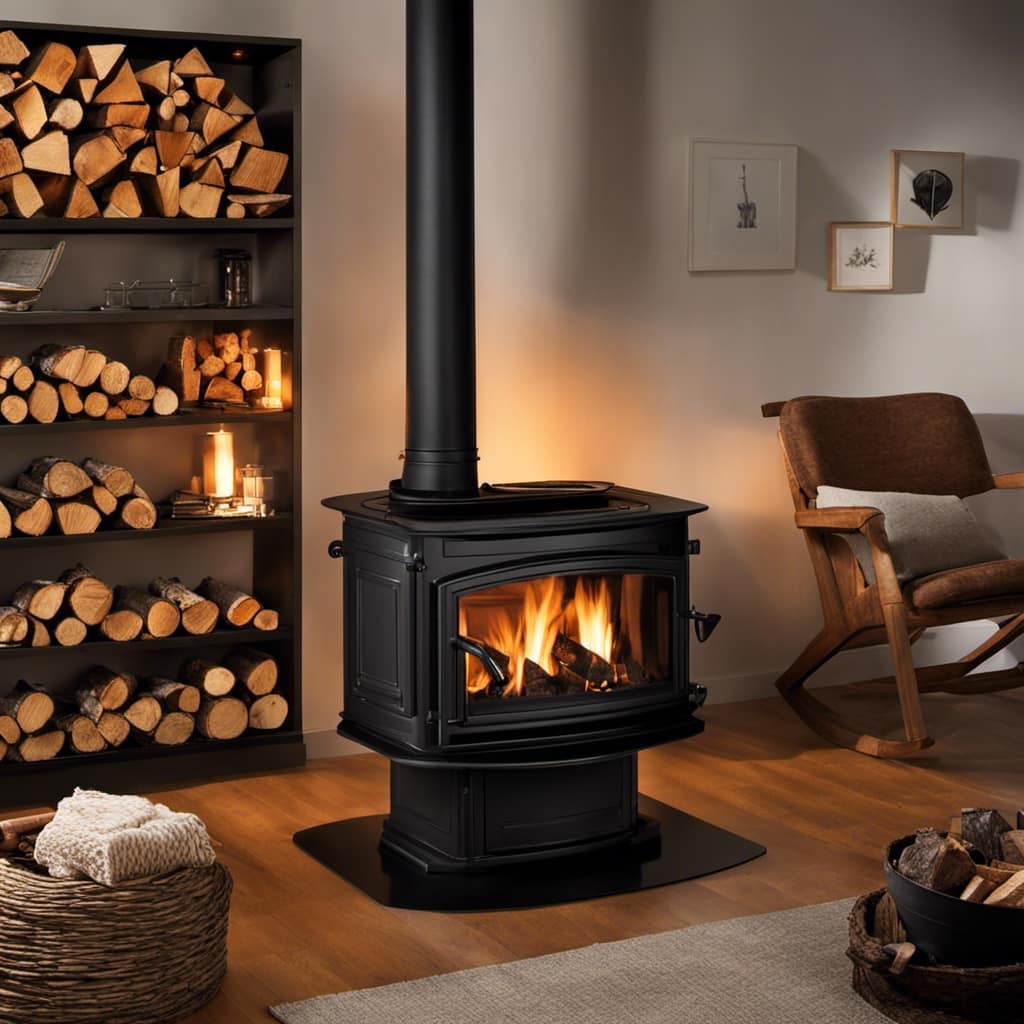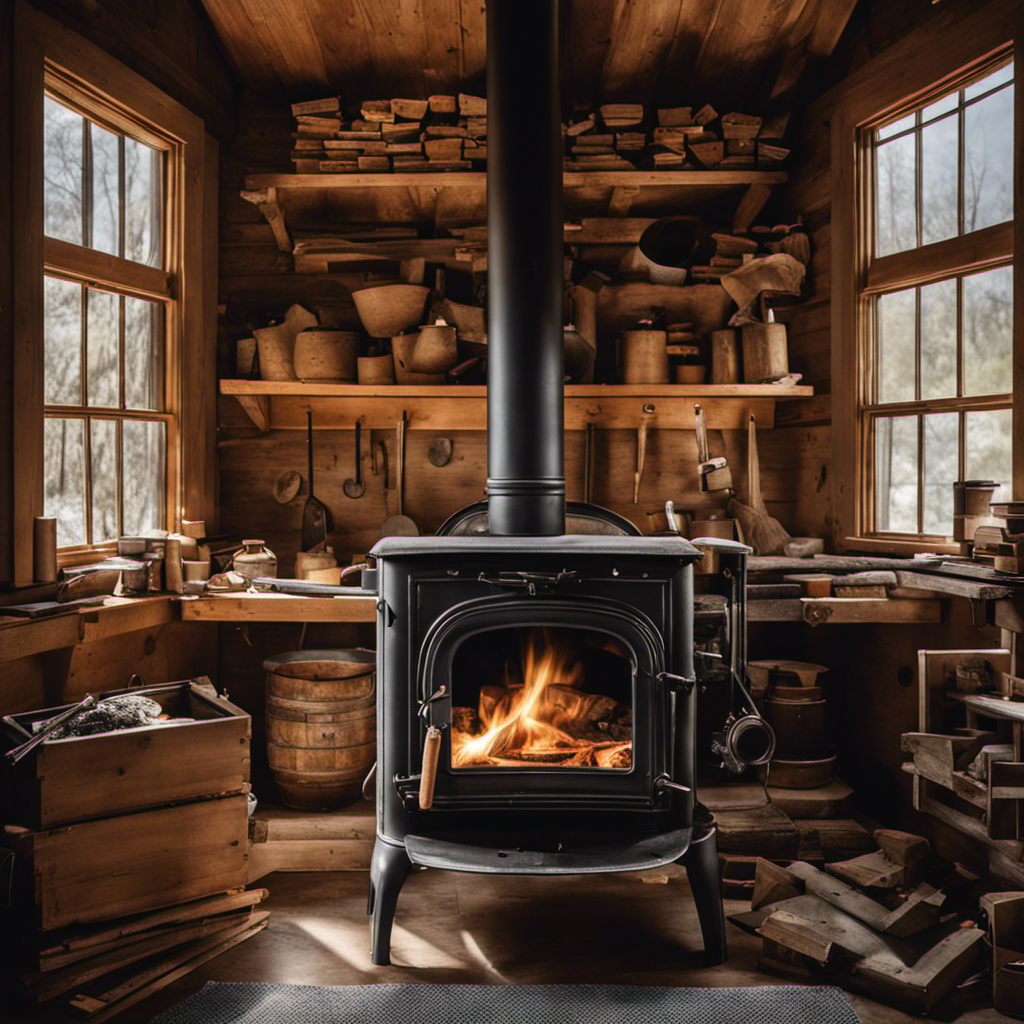I must admit, using a wood stove without a blower may seem intimidating at first, but believe me, it can be done!
In this article, I’m gonna walk you through the ins and outs of running a wood stove without that fancy blower.
I’ll cover everything from understanding the basics to maximizing heat output and ensuring your safety.
So, grab your firewood and let’s dive into the world of efficient wood stove operation!

Key Takeaways
- Regular cleaning and maintenance are essential for safe and efficient operation of a wood stove without a blower.
- Ensuring proper airflow through regular chimney inspection and cleaning is crucial for optimal heating.
- Choosing the right type of wood, such as hardwoods or seasoned wood, is important for optimal burning.
- Mastering the art of fire building, including using dry and seasoned wood and adjusting the damper, helps maintain consistent temperature and efficient burning.
Understanding the Basics of a Wood Stove
I love using my wood stove during the winter because it provides cozy warmth, and understanding the basics of a wood stove helps me operate it safely and efficiently.
Wood stove maintenance is crucial for its longevity and optimal performance. Regular cleaning is necessary to remove creosote buildup, which can cause chimney fires. I make sure to clean the ashes from the firebox regularly, ensuring proper air circulation and preventing overheating.
Troubleshooting common wood stove issues is also important. If I notice weak flames or difficulty in lighting the fire, I check the air vents to ensure they’re open and free from obstructions. Additionally, I inspect the door gaskets for any wear or damage to maintain a tight seal.
Understanding these maintenance and troubleshooting techniques allows me to enjoy the warmth and comfort of my wood stove throughout the winter season.

Ensuring Proper Airflow for Efficient Heating
To ensure efficient heating, I always make sure to clean the air vents and remove any obstructions. Proper airflow is crucial for the optimal functioning of a wood stove.
One important aspect of maintaining good airflow is chimney maintenance. The chimney acts as a pathway for the smoke to exit, and any blockages or buildup can hinder the flow. Regular inspection and cleaning of the chimney are essential to prevent the accumulation of creosote and other debris.
Another way to control airflow is by using dampers. Dampers are devices that regulate the amount of air entering the stove, thus controlling the burn rate and heat output. By adjusting the dampers, you can increase or decrease the airflow, ensuring efficient combustion and heat distribution.
It’s crucial to understand the importance of chimney maintenance and the use of dampers to maintain proper airflow in a wood stove.

Choosing the Right Wood for Optimal Burning
There are three types of wood that are ideal for optimal burning: hardwoods, softwoods, and seasoned wood. Choosing the right firewood is crucial for preventing overheating and ensuring efficient heating in a wood stove.
| Type of Wood | Characteristics | Best Use |
|---|---|---|
| Hardwoods | Dense and | Long, |
| slow-burning | consistent | |
| heat | ||
| ————– | —————– | ———- |
| Softwoods | Less dense and | Quick, |
| fast-burning | intense | |
| heat | ||
| ————– | —————– | ———- |
| Seasoned wood | Moisture content | General |
| below 20% | heating | |
| purposes |
Hardwoods, such as oak or maple, are known for their density and slow-burning properties, providing a long-lasting and consistent heat output. Softwoods, like pine or fir, are less dense and burn quickly, producing an intense heat. Seasoned wood, which has been properly dried to a moisture content below 20%, is suitable for general heating purposes. It is important to avoid using green or wet wood, as it can lead to incomplete combustion, excessive smoke, and creosote buildup.
Mastering the Art of Fire Building
Building a fire with the right amount of kindling and logs is essential for achieving a warm and cozy atmosphere in the house. When it comes to controlling smoke emissions and managing wood stove temperature, there are a few key factors to consider:
-
Proper air circulation: Ensuring that there’s enough airflow in the stove is crucial for efficient burning and reducing smoke emissions.

-
Using dry and seasoned wood: Wet or unseasoned wood can lead to smoky fires and a buildup of creosote in the chimney.
-
Building the fire correctly: Starting with small pieces of kindling and gradually adding larger logs helps maintain a consistent temperature and minimize smoke.
-
Adjusting the damper: The damper controls the airflow and temperature inside the stove, so it’s important to find the right balance to prevent excessive smoke.
-
Regular maintenance: Keeping the stove clean and inspecting it regularly ensures optimal performance and reduces the risk of smoke-related issues.

Maximizing Heat Output and Safety Measures
I can increase the heat output and maintain safety by regularly cleaning and inspecting my wood stove. Maximizing safety precautions is crucial when operating a wood stove.
Regular cleaning of the stove helps to prevent the buildup of creosote, which can lead to dangerous chimney fires. Inspecting the stove ensures that all components are functioning properly and that there are no leaks or cracks that could pose a safety risk.
In addition to these safety measures, there are alternative heat distribution methods that can help maximize the efficiency of a wood stove. One such method is using a heat-powered fan to circulate the warm air throughout the room. Another option is installing a heat transfer system to distribute the heat to other areas of the house.
Frequently Asked Questions
Can I Use a Wood Stove Without a Blower for Extended Periods of Time?
I can use a wood stove without a blower for extended periods of time. There are alternative heating methods available, but using a blower has benefits such as increased heat distribution and efficiency.

What Are Some Alternative Methods to Distribute Heat From a Wood Stove Without a Blower?
Well, when it comes to distributing heat from a wood stove without a blower, there are a few creative alternatives. You can try using a heat-powered fan, strategically placing fans around the room, or even using a duct system.
Are There Any Specific Maintenance Tips for a Wood Stove Without a Blower?
Maintenance tips for a wood stove without a blower include regularly cleaning the chimney, inspecting the stove for any signs of damage, and ensuring proper airflow. Safety precautions are important to prevent any potential fire hazards.
How Can I Improve the Efficiency of a Wood Stove Without a Blower?
To maximize the efficiency of a wood stove without a blower, alternative heat distribution methods can be used. By strategically placing fans or utilizing a heat-powered fan, you can ensure that the heat is evenly distributed throughout the space.
Are There Any Safety Concerns When Operating a Wood Stove Without a Blower?
When operating a wood stove without a blower, it is important to consider safety precautions and adhere to maintenance guidelines. Regular cleaning, proper ventilation, and using fire-resistant materials are essential for safe operation.

Conclusion
In conclusion, operating a wood stove without a blower requires a thorough understanding of its basics and proper airflow. Just like a skilled conductor leads an orchestra, carefully managing the air intake and distribution ensures efficient heating.
Choosing the right wood is like selecting the perfect instrument, creating optimal burning conditions. Building a fire with precision is akin to composing a musical masterpiece.
By maximizing heat output and adhering to safety measures, you can enjoy the warmth and beauty of your wood stove without relying on a blower.
Growing up surrounded by the vast beauty of nature, Sierra was always drawn to the call of the wild. While others sought the comfort of the familiar, she ventured out, embracing the unpredictable and finding stories in the heartbeat of nature.
At the epicenter of every remarkable venture lies a dynamic team—a fusion of diverse talents, visions, and passions. The essence of Best Small Wood Stoves is crafted and refined by such a trio: Sierra, Logan, and Terra. Their collective expertise has transformed the platform into a leading authority on small wood stoves, radiating warmth and knowledge in equal measure.











